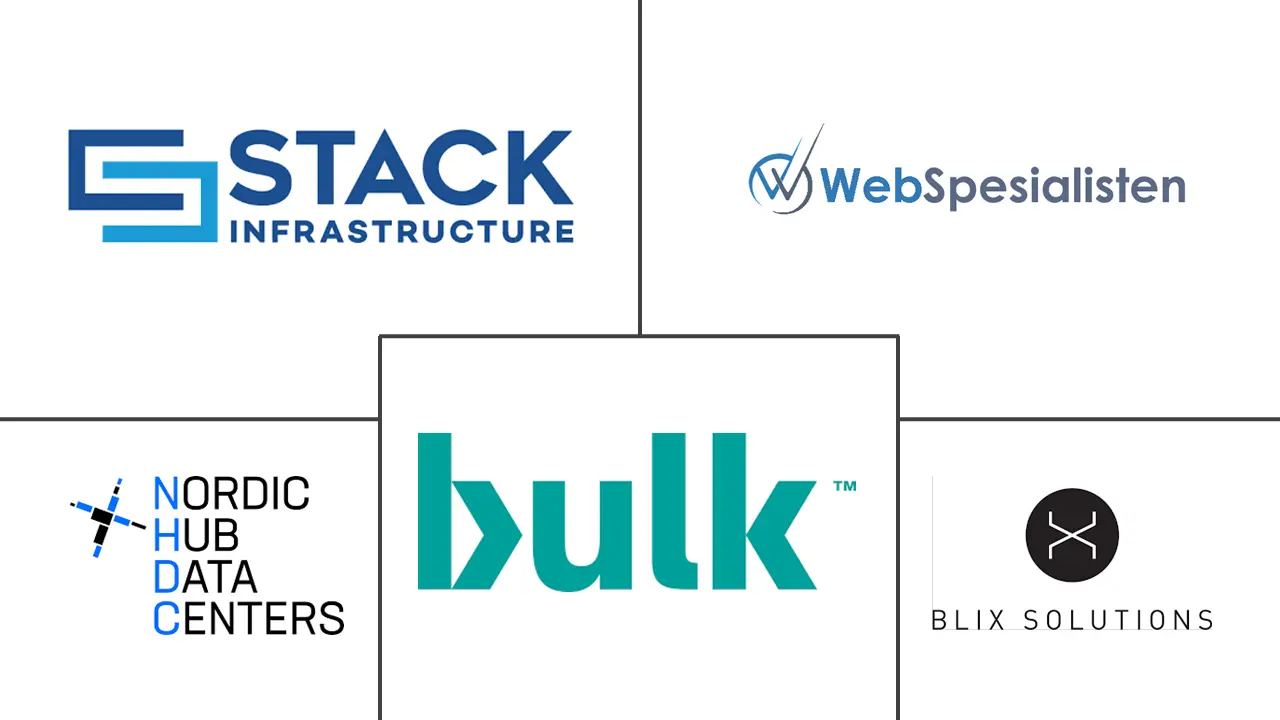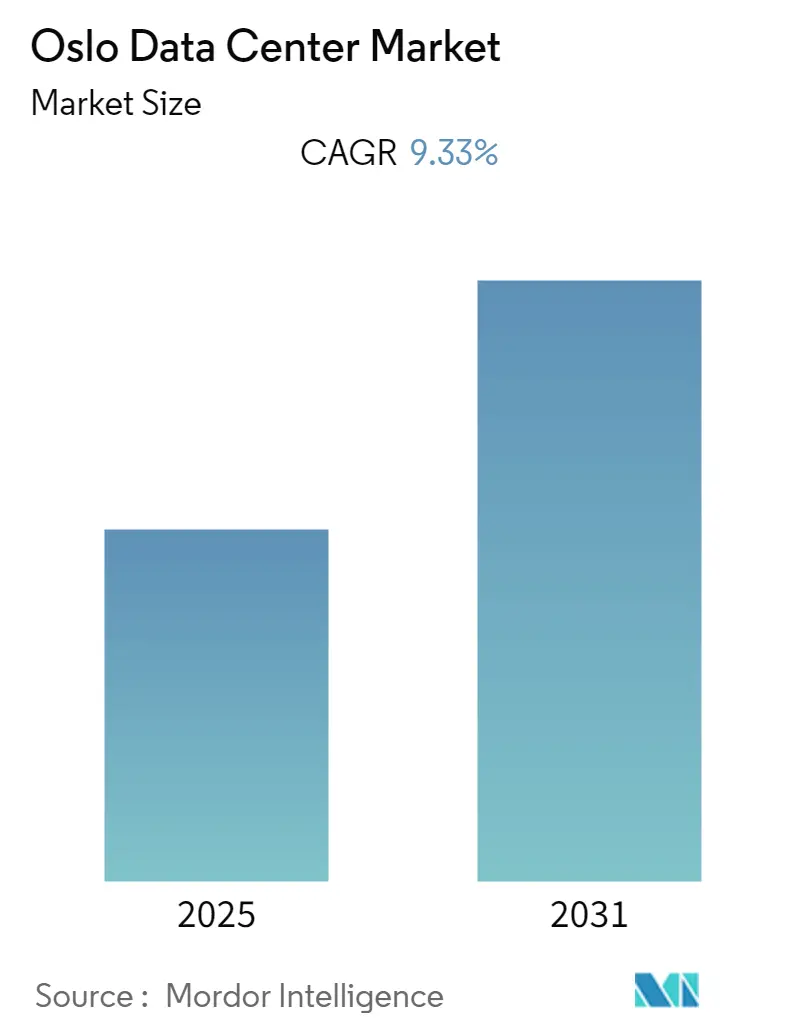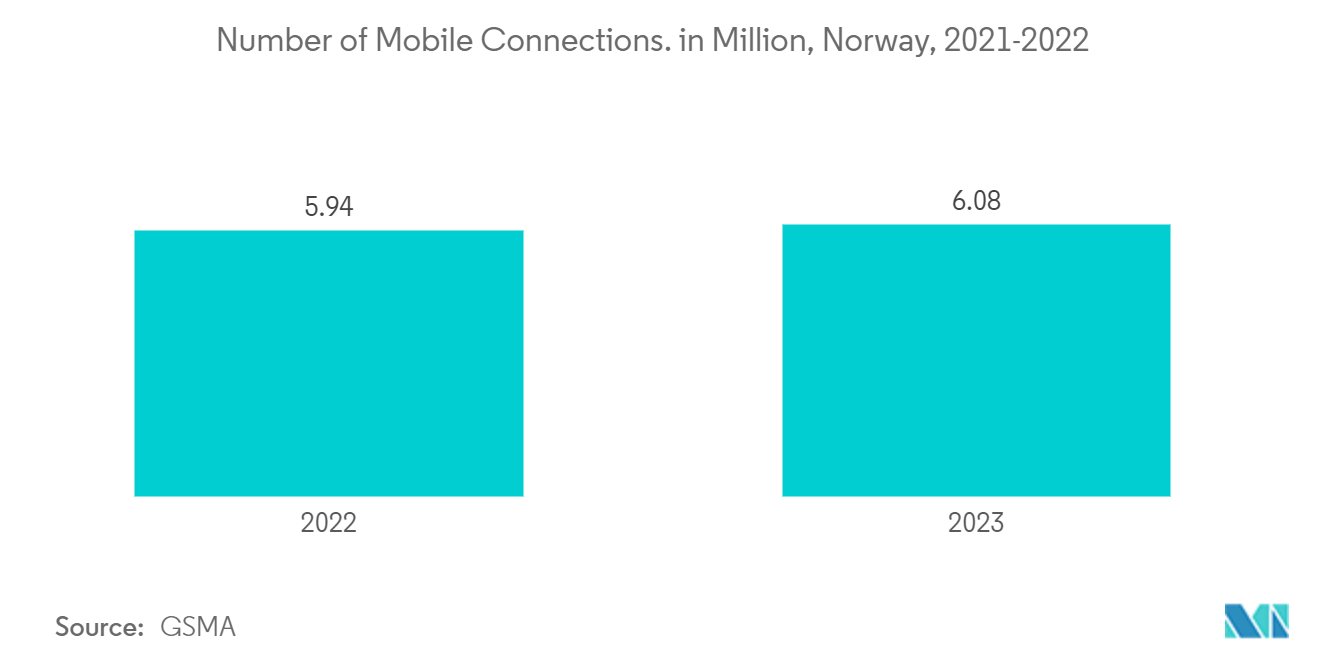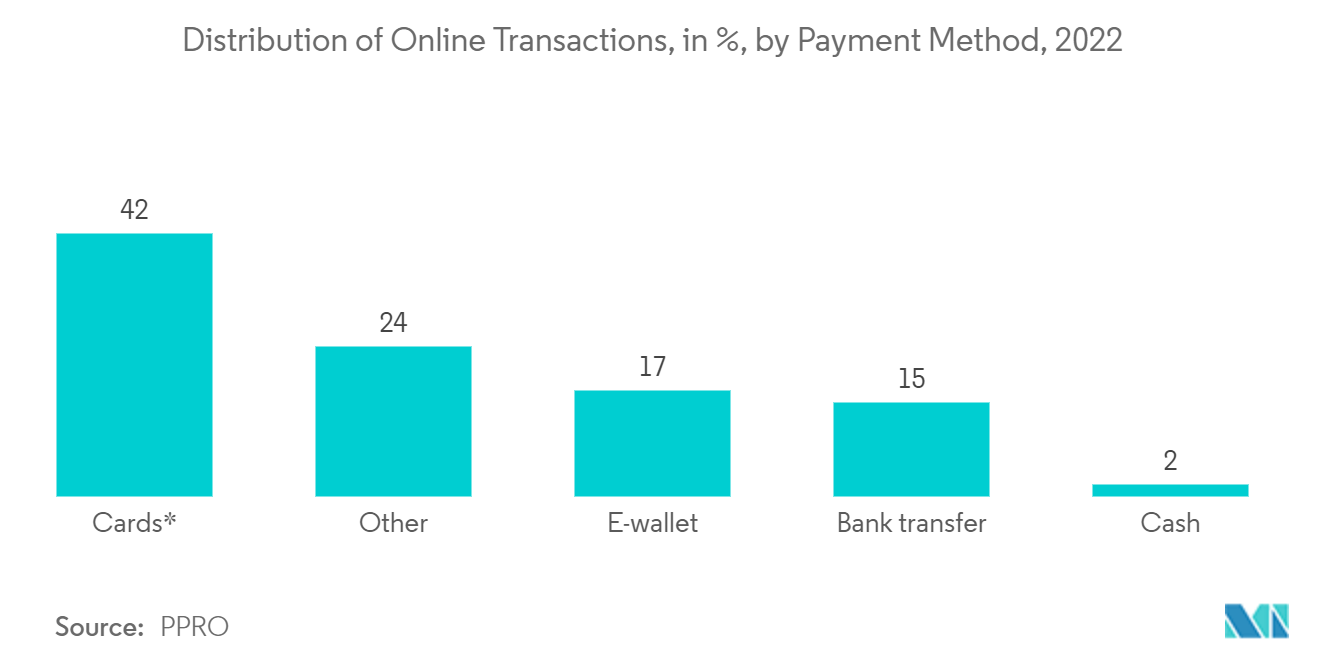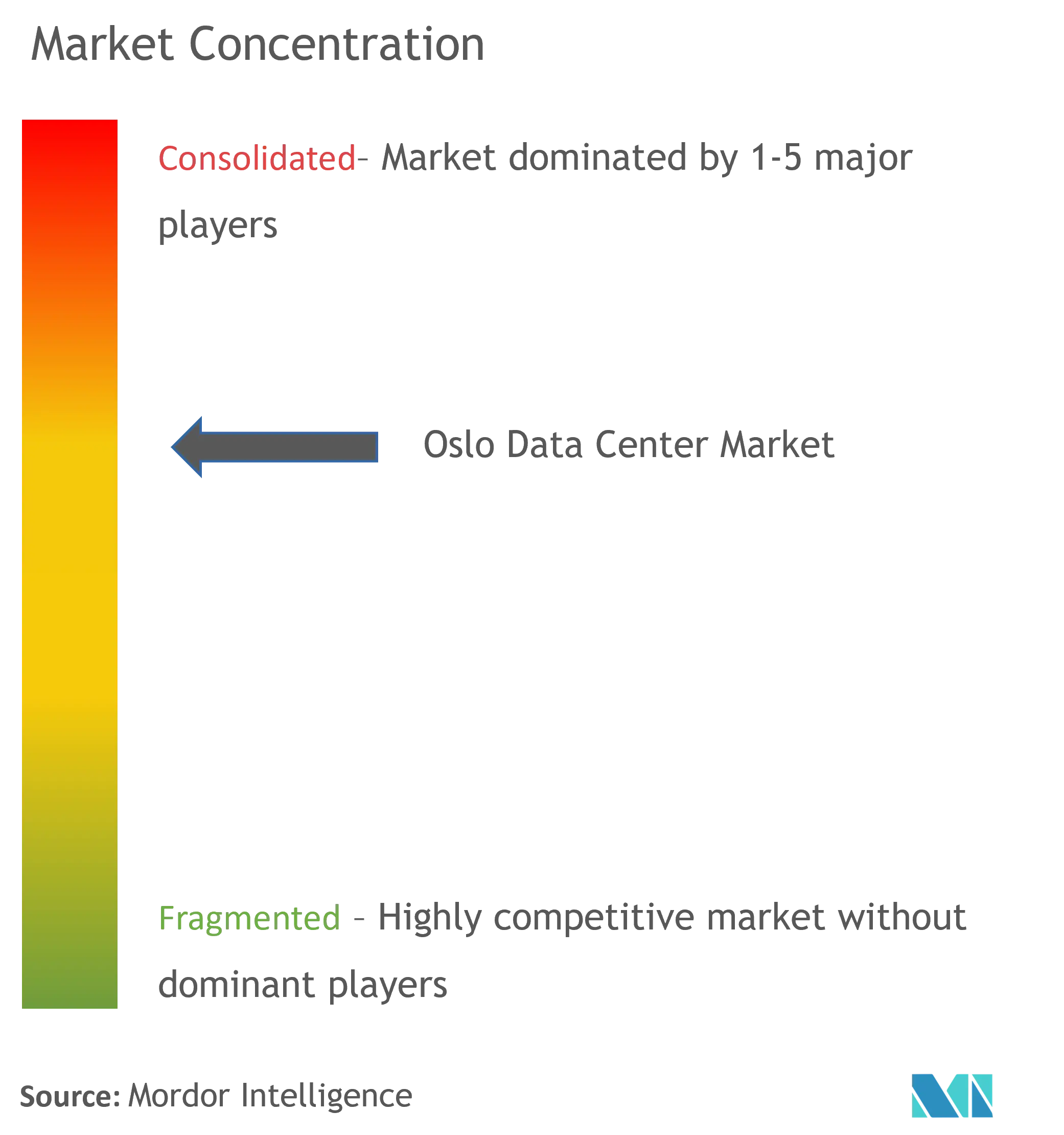Oslo Data Center Market Analysis
The Oslo Data Center Market is expected to register a CAGR of 9.33% during the forecast period.
The main drivers anticipated to drive market expansion are the increasing demand for energy-efficient data centers, considerable investment by colocation and managed service providers, and expanding hyperscale data center buildings. Additionally, the development of big data, cloud computing, and the Internet of Things (IoT) has made it possible for businesses to invest in new data centers to preserve business continuity.
- Additionally, industrial development is expected to prosper due to the rising need for security, operational efficiency, improved mobility, and bandwidth. Software-based data centers boost industry growth by providing a higher level of automation.
- The Norwegian government has been actively promoting the establishment of data centers in Oslo, citing its cool climate and use of renewable energy as advantages for such facilities. The government released its data center strategy, "Powered by Nature," which aims to make Norway a leading location for data centers powered by renewable energy. The government is also encouraging data centers and other large electricity users to explore offering their waste heat to district heating schemes to improve energy efficiency. In addition, the government supports establishing data centers in Oslo through initiatives such as tax incentives and direct investment.
- Going green is no longer simply an industrial goal but is being aggressively pursued to attain the goal of negative carbon footprints. Businesses and data center service providers are investigating energy efficiency, water usage, and waste output. Organizations like Microsoft aim to make their DC operations run entirely on renewable energy. Companies in the data center technology industry are also experimenting with Tesla Megapacks for large-scale energy storage. This will aid in increasing the use of solar energy in large data centers. Businesses' climate action framework will undergo a dramatic paradigm shift in 2022.
- More than any other application, artificial intelligence (AI) with machine learning (ML) requires the construction of a whole new data center architecture. AI and machine learning (ML) may require three times the power density of typical data processing, necessitating a data center architecture revolution. To sustain the higher output, specialized cooling systems are also required. Because of the intensive nature of AI and ML computations, there may be a large dispersion of computational, memory, and storage resources among multiple processors in a computing cluster.
- Furthermore, development centers have conducted extensive research on energy efficiency in data centers, focusing on optimal service quality, effective resource utilization, and cost-cutting operations. They want to reduce brown energy use by providing a load-balancing system that maximizes available green energy. Load balancing is a renewable energy-based technology implemented in various data centers. A workload and energy management plan was implemented to reduce network operational and energy expenses. Combined cooling, heating, and power (CCHP) systems can significantly reduce carbon emissions and air pollution while enhancing resource efficiency.
Oslo Data Center Market Trends
Tier 3 is Expected to Hold Significant Share of the Market
- To be defined as a Tier III facility, a data center must adhere to the following specifications: The facility should offer N+1 (the amount required for operation plus a backup) fault tolerance. Also, Tier III facility providers can undergo routine maintenance without a hiccup in the overall operations. However, unplanned maintenance and emergencies may cause problems affecting the system. These problems could affect customer-facing operations.
- These data center facilities provide 99.98% uptime. The companies using these Tier III facilities are often growing companies or businesses that are considerably larger than the average SMB (small to medium businesses). These Tier III facilities also offer most of the features of a Tier IV infrastructure facility without some elite protection. For instance, enterprises can leverage the advantages of dual power sources and redundant cooling as long as the network streams are fully backed up.
- Moreover, owing to the robust cloud market growth amid the global pandemic, many companies accelerated their digital transformation efforts. Companies like Tencent Cloud added four data centers to increase global coverage by 30% in 2021. The company added four new data center locations globally, of which one is a Tier III facility located in the prime network hub of Frankfurt. The move expands its network footprint to 27 regions and 66 availability zones worldwide. Such expansion efforts are increasing the city's adoption of Tier III facilities.
- The difficulties of maintaining a private IT infrastructure have long prompted businesses to investigate other data and computing solutions. Companies may get all of the power and control of an on-premises solution with the flexibility and cost-effectiveness of the cloud by using colocation data centers. Today's data center providers are using the data center as a service (DCaaS) model to offer attractive solutions for fast-growing businesses trying to compete in an increasingly congested market where speed and adaptability are crucial to success.
- According to GSMA Intelligence, there were 6.08 million cellular mobile connections in Norway at the beginning of 2023. Between 2022 and 2023, the number of mobile connections in Norway increased by 28 thousand (+0.5%). Such a huge rise in mobile connections would create an opportunity for the studied market to grow. Data centers can be used in a multitude of ways to support smartphone applications. One common use case is to host the backend infrastructure and services that power the app, such as databases, caching servers, and APIs. These services can be housed in a cloud-based data center, which provides scalable computing resources and storage capacity.
BFSI is Expected to Drive the Market
- The BFSI industry has been one of the most influenced by enterprises' digital transformation, allowing for more cost-effective revenues. The rising adoption of mobile phones and high-speed internet has pushed individuals to choose digital banking, which has also integrated robust CRM and cloud technologies to store and analyze data, which is projected to boost market growth. The rapid expansion of electronic banking, digital storage, and virtualization in the BFSI sector will likely drive demand for cost-effective and energy-efficient data center solutions. It enables the consistent and reliable availability of IT and digital banking services in a highly protected environment. It can also connect and encrypt all device communications while controlling user access to protect against errors and bad intent.
- Moreover, banks and insurance companies must reinvent themselves due to changing regulations, emerging technology, elevated client expectations, and the entry of disruptive competitors. In the fintech industry, online lending has increased in demand. Thus, online banking will become more popular each year, and it is expected to increase the demand for resilient, safe, cost-effective, and energy-efficient data center solutions, driving the need for data center construction.
- Furthermore, advances in digitization, such as the introduction of PSD2 and robust e-commerce growth, would likely pave the way for the development of numerous new payment methods. A growing range of payment methods, including Apple Pay, Google Pay, RatePay, Amazon Pay, and many more, are expected to boost the rise of digital payments. This is predicted to generate a massive amount of data, increasing the demand for cloud adoption and, in turn, increasing the need for data center building around the city.
- The digital ecosystem surrounding a bank is exploding at a rapid pace. With the constant change in consumer demand, banks have been pressured to customize their product offerings according to their needs. Secondly, consumers who embrace a mobile lifestyle and socialize on digital platforms expect banks to connect with them on the same medium. This is affecting the demand for the construction of data centers in the BFSI sector.
- According to PPRo, cards were the most popular payment method for online purchases in Norway in 2022, accounting for 42 percent of all purchases. This proportion stood at 17% for online transactions utilizing e-wallets, while bank transfers accounted for 15% of e-commerce checkouts. Such a rise in online purchases would increase the amount of data created by the banks, which may increase the demand for data centers in the city.
Oslo Data Center Industry Overview
The Oslo data center market is moderately consolidated with several players like Stack Infrastructure, Inc., Bulk Infrastructure Group AS, Blix Solutions AS, etc. The companies continuously invest in strategic partnerships and product developments to gain substantial market share. Some of the recent developments in the market are:
In May 2023, DE-CIX announced that its new DE-CIX IXs were available in Oslo and Kristiansand bulk data centers. Its InterconnectionFLEX service will be available through a collaboration with Bulk Infrastructure Group, providing users with an interconnection package for peering, cloud connectivity, and private network interconnects (PNIs). Customers will also have direct access to more than 50 clouds, 2000+ local and international networks, and more than 250 data centers in Germany, Southern Europe, and the United States.
In January 2023, Green Mountain completed building a new 13.5 MW data center adjacent to its current OSL1-Enebakk campus. This is the campus's third data center, designed for colocation. With this addition, the data center campus in Enebakk now has three data centers. The first two 4MW data centers will house a single tenant, while the third 13.5MW structure will host multiple tenants. The 10,000 m2 three-story building is designed to Tier 3 standards and has 1,300 m2 of white space on each floor. Capacity has already been reserved for numerous clients, although there is still some available capacity in this building and future planned campus extensions.
Oslo Data Center Market Leaders
-
Stack Infrastructure, Inc.
-
Bulk Infrastructure Group AS
-
Blix Solutions AS
-
Nordic Hub Data Centers AS
-
Webspesialisten AS
-
Green Mountain AS
-
Orange Business Service
- *Disclaimer: Major Players sorted in no particular order
Oslo Data Center Market News
- September 2022: Bulk announced several expansion initiatives at its Norwegian data center locations, with investments focused on ensuring long-term power and land availability. Highly connected and scalable sites powered by 100% renewable energy are provided. With many European locations battling with power restrictions and increasing demand for data center capacity, Bulk completed the installation of the N01 onsite substation, which provides 125 MVA of dual connections to the adjacent Kristiansand substation.
- September 2022: Stack Infrastructure successfully connected an Oslo data center to the local district heating system four years after DigiPlex began the project. The OSL01 data center has been linked to Hafslund Oslo Celsio's district heating system in the Norwegian capital. Following a one-year ramp-up period, waste heat from the facility is now expected to provide heat and hot water for up to 5,000 houses.
Oslo Data Center Industry Segmentation
A data center is a physical room, building, or facility that holds IT infrastructure used to construct, run, and provide applications and services, as well as store and manage the data connected with them.
The Oslo data center market is segmented by DC size (small, medium, large, massive, mega), by tier type (tier 1 and 2, Tier 3, Tier 4), by absorption (utilized, colocation type (retail, wholescale, hyperscale), end-user (cloud & IT, telecom, media & entertainment, government, BFSI, manufacturing, e-commerce), and non-utilized).
The market sizes and forecasts are provided in terms of volume (MW) for all the above segments.
| DC Size | Small | |||
| Medium | ||||
| Large | ||||
| Massive | ||||
| Mega | ||||
| Tier Type | Tier 1 & 2 | |||
| Tier 3 | ||||
| Tier 4 | ||||
| Absorption | Utilized | Colocation Type | Retail | |
| Wholesale | ||||
| Hyperscale | ||||
| End-User | Cloud & IT | |||
| Telecom | ||||
| Media & Entertainment | ||||
| Government | ||||
| BFSI | ||||
| Manufacturing | ||||
| E-Commerce | ||||
| Other End-User | ||||
| Non-Utilized | ||||
Oslo Data Center Market Research Faqs
What is the current Oslo Data Center Market size?
The Oslo Data Center Market is projected to register a CAGR of 9.33% during the forecast period (2025-2031)
Who are the key players in Oslo Data Center Market?
Stack Infrastructure, Inc., Bulk Infrastructure Group AS, Blix Solutions AS, Nordic Hub Data Centers AS, Webspesialisten AS, Green Mountain AS and Orange Business Service are the major companies operating in the Oslo Data Center Market.
What years does this Oslo Data Center Market cover?
The report covers the Oslo Data Center Market historical market size for years: 2019, 2020, 2021, 2022, 2023 and 2024. The report also forecasts the Oslo Data Center Market size for years: 2025, 2026, 2027, 2028, 2029, 2030 and 2031.
Our Best Selling Reports
Oslo Data Center Industry Report
Statistics for the 2025 Oslo Data Center market share, size and revenue growth rate, created by Mordor Intelligence™ Industry Reports. Oslo Data Center analysis includes a market forecast outlook for 2025 to 2031 and historical overview. Get a sample of this industry analysis as a free report PDF download.

